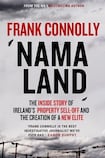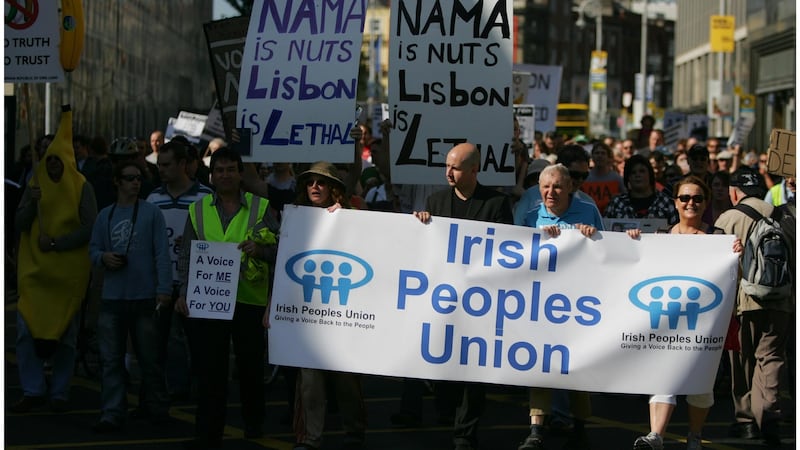
It may have seemed in 2008 that Ireland, which had nothing but bad banks, did not need another one. But as the cataclysmic collapse of the banking system threatened to engulf the State itself, there was a rush towards the idea of the superbad bank, the sin-eater that would take on all the toxic debt and leave the other institutions free to begin again. Thus Ireland quite suddenly found itself the not so proud owner of the largest property management company in the world, the National Asset Management Agency. Nama “bought” €74 billion of loans from the banks for €31.8 billion and was given the job of getting back for the benighted taxpayer at least as much as it had paid for them. In the process, of course, it was quietly accepted that more than €30 billion of public money was being vaporised. Nama’s ultimate “profits” for the taxpayer would simply be the other side of losses for the taxpayer-owned banks.
Startlingly, as Frank Connolly reminds us in his very valuable, admirably lucid and deeply researched account of Nama’s history, the then minister for finance Brian Lenihan proposed that Nama be chaired by Michael McDowell, a barrister and former leader of the Progressive Democrats, a party whose “free market” ideology had helped to create the disastrous regime of “light touch” banking regulation. That was a step too far even for the then taoiseach Brian Cowen, but it did indicate the extent to which Nama was always conceived of as an inside job, a repair of the system, by the system, for the system. (In the end, the job of chairing Nama went to a more uncontroversial figure, former Revenue chairman Frank Daly.)
This impression was confirmed by key appointments being made from within the banking and property establishments: John Mulcahy on secondment from Jones Lang LaSalle as head of portfolio management (subsequently as executive director), Ronnie Hanna from Ulster Bank as head of credit and risk. (After he left Nama, Mulcahy took up a role as adviser to Denis O’Brien on his large overseas property portfolio. Hanna left Nama in 2014 but remains a central figure in continuing investigations into sale of Nama’s massive Project Eagle portfolio in Northern Ireland. The portfolio had a face value of €5.1 billion. The vulture fund Cerberus got it for just €1.5 billion.) The chairman of the ministerial advisory committee overseeing Nama, Michael Geoghegan, came from the controversial bank HSBC.
It is perhaps unsurprising, given that many of them had come from the property world, that some Nama executives were subsequently invited to work for the very companies whose portfolios they had been handling: Graham Emmett, Nama’s head of lending, was offered the role of chief executive of Ballymore Properties’s British operations before he left Nama, where he had dealt with Ballymore loans.
It was clear from the beginning that Nama would be a kind of outdoor famine relief scheme for the distressed professional classes. At a time when the State was allegedly broke and could not afford basic supports for carers or vulnerable children, Nama set aside an astonishing €2.6 billion for professional fees for lawyers, accountants and property wallahs. Their job, when it is boiled down, was essentially the selling of vast amounts of Irish property in huge bundles, in the main to opportunistic US-based funds: Cerberus, Goldman Sachs, CarVal, LoneStar, Oaktree, Blackstone, Pacific, Davidson Kempner, Apollo and so on. But these funds needed local expertise and filling that need has been a lucrative business. One legal firm alone, Arthur Cox, has earned almost €40 million from Nama-related work.
And for the vulture funds this was money well spent. It was presumably local experts who suggested that the vulture funds could establish charitable trusts to help them pay little or no tax on the bonanzas they would earn from buying assets cheap and sweating them for all they were worth by pushing rental values in Dublin up to unprecedented levels.
This fine book is one in which every Irish citizen literally has a stake
Bad feeling towards Nama among property developers has to be taken, of course, with a shipping container of salt. Some of them were simply enraged that they could not hold on to their assets. Ray Grehan, who infamously paid a world-record €84 million an acre for a site in Ballsbridge at the height of the property madness, sold a quarter share of a casino in the Netherlands worth €50 million to his own daughter for €1 in 2011. Nama’s pursuit of Sean Dunne in the US courts is seen by him as a “witchhunt” – others may see it as the fulfilment of a duty to recover public money.
Much of Connolly’s material is already on the public record, in the transcripts and reports of the Dáil’s Public Accounts Committee, in a value-for-money audit by the Comptroller and Auditor General and in the Stormont hearings into the notorious Project Eagle. (There is a commission of investigation into this sale south of the Border but it is working in private. Eight people remain under criminal investigation in Northern Ireland.)
But this is not a criticism: Connolly provides a vital public service in putting all of this material into a coherent narrative and he fleshes it out with a great deal of original reporting. His tone is careful and considered – quite understandably he relies for his most acerbic commentary on the privileged Dáil statements of Nama’s great nemesis, Mick Wallace.
As Connolly acknowledges, Nama Land is “not a complete account of the Nama story”. Indeed, that account may never be written: as Connolly points out, in March 2015 Nama decided to allow the “routine destruction” of its own email records: “This extraordinary remit to destroy work done by the public service applied to emails of staff or board members who had left the agency for more than a year.”

Nama also tried to insist that it was not a public body and therefore not subject to Freedom of Information requests. Even when this claim was rejected by the High Court, Nama files released under FoI have been very heavily redacted. (Ironically, there were huge leaks of confidential Nama valuations, including of its entire US portfolio, to potential investors by departing executive Enda Farrell, who received a two-year suspended prison sentence in 2012. Connolly also reports on allegations to him by the developer Gerry Barrett about the leaking of his Nama files to an interested party.)
Judgments about Nama’s general efficacy are thus impossible. We don’t know, for example, whether the public statement by the developer Sean Mulryan in December that he had “satisfied his obligations” of €3.2 billion to Nama means that he actually paid that amount or made a settlement for a smaller sum. Crucially, we don’t yet know what the civil and criminal investigations into Project Eagle will conclude. In the end, Nama hopes to return a surplus of €3 billion when it winds up in 2020. Whether a higher return could have been gained and whether Nama could have been used more constructively to create a sustainable housing market remain open questions. In the meantime, this fine book is one in which every Irish citizen literally has a stake.
Fintan O’Toole’s Judging Shaw is published by the Royal Irish Academy












